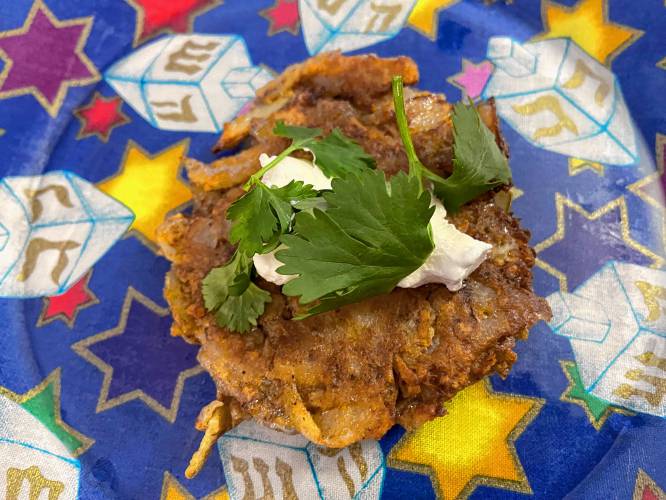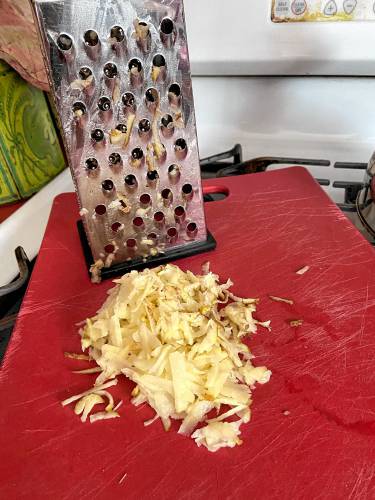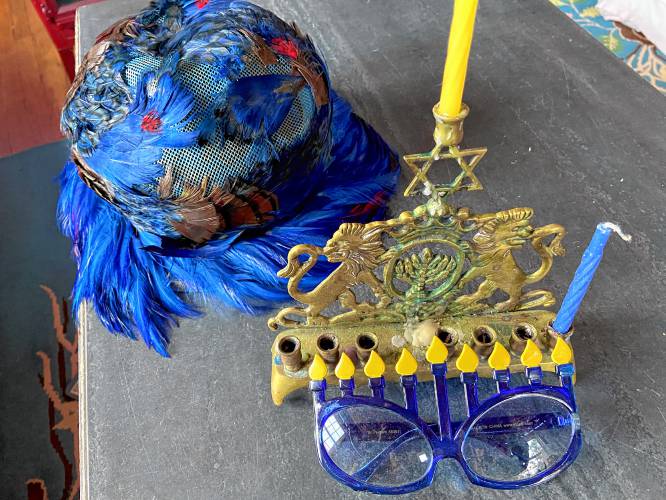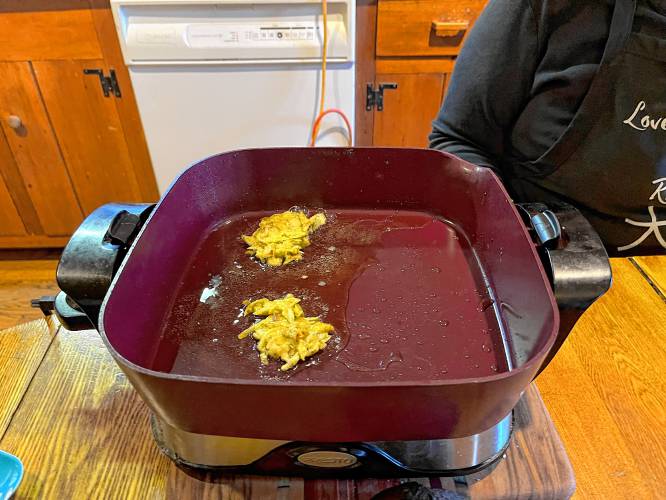A new approach to the ever-evolving latke: Trying out Southwestern Latkes for Hanukkah this year
| Published: 12-23-2024 12:09 PM |
Hanukkah begins Wednesday night, Christmas night. I love having the two holidays coincide, which they don’t always do since Hanukkah is determined by a lunar calendar. I celebrate both so it tickles me to wallow in celebration and to sing Christmas carols and Hanukkah songs in quick succession.
My favorite Hanukkah song isn’t ”Dreidel, Dreidel, Dreidel,” which revolves around (pun intended) the holiday’s signature toy (a top) or “The Hanukkah Song,” although I sing both these traditional ditties from time to time.
Oddly, it’s a 21st-century song from the 2008 holiday special “A Colbert Christmas: The Greatest Gift of All.” The show had an extremely flimsy plot: comedian Stephen Colbert was trapped in a cabin in the woods somewhere in “bear country,” perhaps even here in western Massachusetts.
Colbert was loath to brave the bears to travel to New York City to record his scheduled holiday special. To make him feel better (and to provide material for the actual special, set in the cabin), several friends stopped by to perform musical numbers for and with him.
These guests included Toby Keith, John Legend, Elvis Costello and Willie Nelson. My favorite song was a duet between Colbert and a non-singer, his colleague Jon Stewart.
In “Can I Interest You in Hanukkah,” Stewart tried to convince his Roman Catholic friend to consider the Jewish festival of lights as an alternative to Christmas.
The song contrasted not just the holidays of Christmas and Hanukkah but also the speech patterns of many East Coast American Christians and Jews.
“Is it jolly?” Colbert asked of the Jewish holiday.
Article continues after...
Yesterday's Most Read Articles
 Marine vet becomes Blessed Trinity Parish’s newest priest in Greenfield
Marine vet becomes Blessed Trinity Parish’s newest priest in Greenfield
 Erving man, 60, found dead in Montague Plains Wildlife Management Area identified
Erving man, 60, found dead in Montague Plains Wildlife Management Area identified
 Chicopee man who drowned in Conway identified
Chicopee man who drowned in Conway identified
 Chicopee man, 21, drowns at Conway Community Swimming Pool
Chicopee man, 21, drowns at Conway Community Swimming Pool
 New living quarters arrive for Northfield EMS
New living quarters arrive for Northfield EMS
 New role focused on downtown development in Northfield, Turners Falls and Shelburne Falls
New role focused on downtown development in Northfield, Turners Falls and Shelburne Falls
“Well, I wouldn’t know from jolly,” replied Stewart, “But it’s not my most unfavorite time of year.”
Many of my Jewish New York kinfolk have a similar self-deprecating, understated way of conversing.
Stewart went on to sum up Hanukkah as celebrating “oil that burned quite slowly.” That doesn’t sound glamorous, but it is accurate.
According to legend, during the second century B.C.E., the residents of Judea, who had been occupied for more than a century by the Greeks, rose up and defeated their invaders.
The Jewish people rebuilt their temple and its altar. To rededicate the temple, they lit an oil-powered menorah (candelabrum) that was supposed to burn continuously.
According to legend, they had only enough oil to keep the flame burning for a single day. To their surprise and joy, it lasted for eight days and nights, until more oil could be brought to the temple.
The eight days of Hanukkah celebrate that miraculous light and the victory over the Greeks. It is traditional to eat foods that are cooked with or contain oil to internalize the memory of the long-lasting menorah.
My family always ate (and always eats) latkes, potato pancakes, sometime during Hanukkah. ”Latke” means “pancake” in Yiddish, the language of Eastern European Jews like my grandparents.
I should say up front that there’s nothing wrong with plain potato pancakes. My family would be happy eating straightforward potato-and-onion latkes each December.
Nevertheless, the food writer in me doesn’t let allow them to do that. Over the years, I have forced my family (and the readers of this column) to brave a variety of latke flavors, from the Samosa Latke (Indian flavors, yum!) to the Guaca-Latke, a potato pancake served with a large dollop of guacamole.
This year I am serving Southwestern Latkes. I have added typical Southwestern seasonings like chiles, cumin, and cilantro to my pancakes.
All this messing about with flavors may strike some traditional Hanukkah lovers as sacrilege. I maintain, however, that I’m just following tradition.
No one in Judea or in Europe ate potato pancakes when Hanukkah was first celebrated. Potatoes are native to the Americas. They didn’t appear elsewhere until the 1500s and didn’t really begin to be consumed en masse around the world until the late 1700s.
Clearly, the latke evolved over time to become the beloved potato pancake we now eat. I’m just encouraging it to evolve a little more.
Go ahead and skip the spices in these pancakes if you feel you must eat traditional latkes. I encourage you to try the recipe as it is, however. You may find, as Jon Stewart might say, that the Southwestern Latke is not your most unfavorite holiday food.
It is certainly not my unfavorite. I really love this combination of flavors. Speaking of flavors, I should add that the spices are all to taste. I don’t usually measure in this sort of recipe so the quantities are approximate.
In addition to the sour cream and cilantro mentioned below, you may garnish your latkes with any other tasty items that strike your fancy. A little salsa would be nice. Grated Cheddar cheese and/or guacamole are among the other possibilities.
Ingredients:
2 large baking potatoes
1 large onion, finely chopped
1 egg, beaten (you may need another one!)
1/2 teaspoon chopped garlic
2 to 4 tablespoons flour
1 teaspoon kosher salt or sea salt
lots of freshly ground pepper
1 teaspoon chili powder
1 teaspoon cumin seeds
red pepper flakes to taste (start with a pinch or 2)
extra-virgin olive oil as needed for frying
sour cream and cilantro as desired
Instructions:
Preheat the oven to 250 degrees. Wash the potatoes well. Grate them with a box grater or with the grater attachment of a food processor.
Wrap the potato shreds in a dish towel. Carry it to the sink, wring it out, and allow the potato pieces to drain into the sink while you assemble the rest of the ingredients and maybe have a cocktail or two.
In a medium bowl combine the potato pieces, the onion pieces, the egg, 2 tablespoons of flour, the salt and pepper, and the spices. In a large frying pan heat a few tablespoons of oil until the oil begins to shimmer.
Scoop some of the potato mixture out with a spoon and flatten it with your hand. Pop the flattened pancake into the hot oil.
The latkes should be a little ragged. If they don’t hold together and are hard to turn, however, add a little more flour to the batter and/or even another egg.
Fry the latkes a few at a time, turning each when the first side browns and is easy to flip. Drain the cooked pancakes on paper towels and pop them into the oven to stay warm until you have finished cooking the rest.
Garnish each latke with a little sour cream and a sprig of cilantro before serving.
Serves 6 to 8 as a side dish. If you have leftovers, feel free to freeze them and reheat them in the oven later during Hanukkah’s eight days.
Tinky Weisblat is an award-winning cookbook author and singer known as the Diva of Deliciousness. Visit her website, TinkyCooks.com.










 ‘Everybody wants to tell their story’: Ten historical societies participating in Hilltown History Trail, Aug. 2
‘Everybody wants to tell their story’: Ten historical societies participating in Hilltown History Trail, Aug. 2 Meet the Bluebird Lady of Birnam Road: Northfield resident shares avian hobby with neighbors
Meet the Bluebird Lady of Birnam Road: Northfield resident shares avian hobby with neighbors ‘Like I'm standing in a room of giants’: Meet Elana Casey, new associate director of the Augusta Savage Gallery at UMass Amherst
‘Like I'm standing in a room of giants’: Meet Elana Casey, new associate director of the Augusta Savage Gallery at UMass Amherst Valley Bounty: The joy of blueberry season: Sobieski’s River Valley Farm in Whately has been growing blueberries since 1977
Valley Bounty: The joy of blueberry season: Sobieski’s River Valley Farm in Whately has been growing blueberries since 1977
